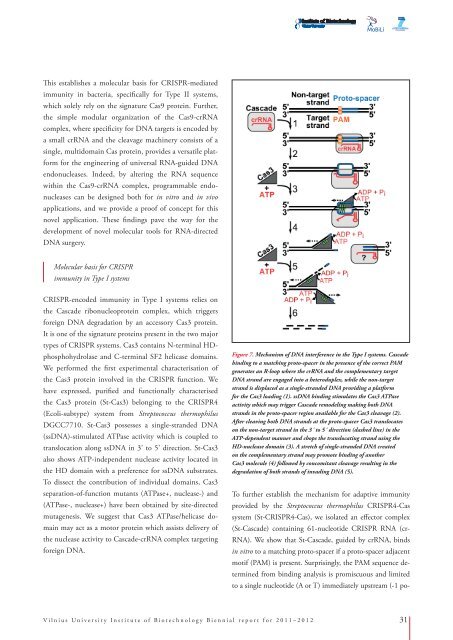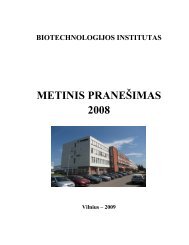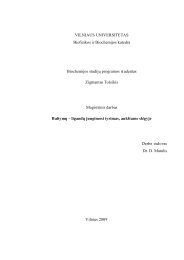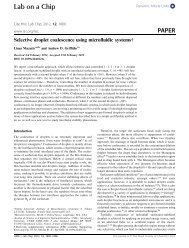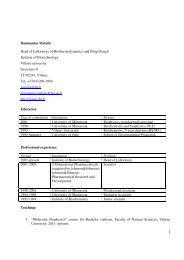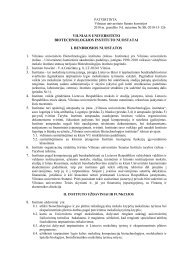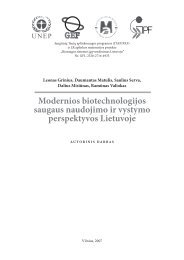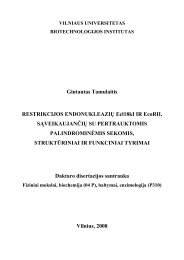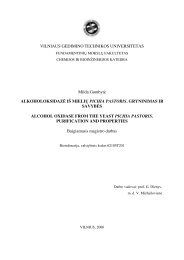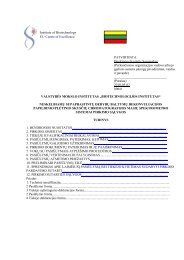Biennial Report 2011â2012
Biennial Report 2011â2012
Biennial Report 2011â2012
You also want an ePaper? Increase the reach of your titles
YUMPU automatically turns print PDFs into web optimized ePapers that Google loves.
This establishes a molecular basis for CRISPR-mediated<br />
immunity in bacteria, specifically for Type II systems,<br />
which solely rely on the signature Cas9 protein. Further,<br />
the simple modular organization of the Cas9-crRNA<br />
complex, where specificity for DNA targets is encoded by<br />
a small crRNA and the cleavage machinery consists of a<br />
single, multidomain Cas protein, provides a versatile platform<br />
for the engineering of universal RNA-guided DNA<br />
endonucleases. Indeed, by altering the RNA sequence<br />
within the Cas9-crRNA complex, programmable endonucleases<br />
can be designed both for in vitro and in vivo<br />
applications, and we provide a proof of concept for this<br />
novel application. These findings pave the way for the<br />
development of novel molecular tools for RNA-directed<br />
DNA surgery.<br />
Molecular basis for CRISPR<br />
immunity in Type I systems<br />
CRISPR-encoded immunity in Type I systems relies on<br />
the Cascade ribonucleoprotein complex, which triggers<br />
foreign DNA degradation by an accessory Cas3 protein.<br />
It is one of the signature proteins present in the two major<br />
types of CRISPR systems. Cas3 contains N-terminal HDphosphohydrolase<br />
and C-terminal SF2 helicase domains.<br />
We performed the first experimental characterisation of<br />
the Cas3 protein involved in the CRISPR function. We<br />
have expressed, purified and functionally characterised<br />
the Cas3 protein (St-Cas3) belonging to the CRISPR4<br />
(Ecoli-subtype) system from Streptococcus thermophilus<br />
DGCC7710. St-Cas3 possesses a single-stranded DNA<br />
(ssDNA)-stimulated ATPase activity which is coupled to<br />
translocation along ssDNA in 3’ to 5’ direction. St-Cas3<br />
also shows ATP-independent nuclease activity located in<br />
the HD domain with a preference for ssDNA substrates.<br />
To dissect the contribution of individual domains, Cas3<br />
separation-of-function mutants (ATPase+, nuclease-) and<br />
(ATPase-, nuclease+) have been obtained by site-directed<br />
mutagenesis. We suggest that Cas3 ATPase/helicase domain<br />
may act as a motor protein which assists delivery of<br />
the nuclease activity to Cascade-crRNA complex targeting<br />
foreign DNA.<br />
Figure 7. Mechanism of DNA interference in the Type I systems. Cascade<br />
binding to a matching proto-spacer in the presence of the correct PAM<br />
generates an R-loop where the crRNA and the complementary target<br />
DNA strand are engaged into a heteroduplex, while the non-target<br />
strand is displaced as a single-stranded DNA providing a platform<br />
for the Cas3 loading (1). ssDNA binding stimulates the Cas3 ATPase<br />
activity which may trigger Cascade remodeling making both DNA<br />
strands in the proto-spacer region available for the Cas3 cleavage (2).<br />
After cleaving both DNA strands at the proto-spacer Cas3 translocates<br />
on the non-target strand in the 3´ to 5´ direction (dashed line) in the<br />
ATP-dependent manner and chops the translocating strand using the<br />
HD-nuclease domain (3). A stretch of single-stranded DNA created<br />
on the complementary strand may promote binding of another<br />
Cas3 molecule (4) followed by concomitant cleavage resulting in the<br />
degradation of both strands of invading DNA (5).<br />
To further establish the mechanism for adaptive immunity<br />
provided by the Streptococcus thermophilus CRISPR4-Cas<br />
system (St-CRISPR4-Cas), we isolated an effector complex<br />
(St-Cascade) containing 61-nucleotide CRISPR RNA (cr-<br />
RNA). We show that St-Cascade, guided by crRNA, binds<br />
in vitro to a matching proto-spacer if a proto-spacer adjacent<br />
motif (PAM) is present. Surprisingly, the PAM sequence determined<br />
from binding analysis is promiscuous and limited<br />
to a single nucleotide (A or T) immediately upstream (-1 po-<br />
Vilnius University Institute of Biotechnology <strong>Biennial</strong> report for 2011–2012 31


